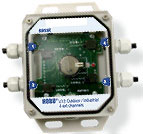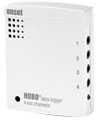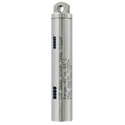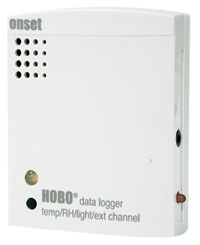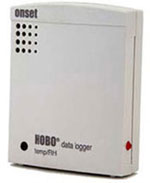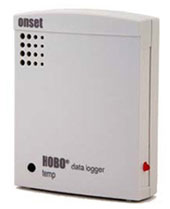Plug-In Smart Sensors are Automatically Recognized
User-Selectable Sampling Rate of 1 Second to 18 Hours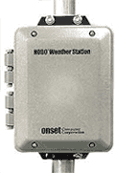 Deploy for 1 Year Using 4 User-Replacable AA Batteries
Deploy for 1 Year Using 4 User-Replacable AA Batteries
Non-Volatile EEPROM Memory Retains Data Even if Batteries Fail
Status Lights Indicate Proper Sensor Connection and Logging
Low-Battery and Low-Memory Warnings
Auxiliary Battery Connection Allows Battery Changes While Logging
Requires Smart Sensors and HOBOWare Pro Software
Compatible with SolarStream Wireless Data Transceiver
The Onset HOBO Weather Station can record up to 15 different outdoor environomental parameters. Temperature, Humidity, Barometric Pressure, Light, Rain Fall, Leaf Wetness and Wind Sensors are available (sold separately) for easy plug-in and automatic detection by the logger. The weather station features multiple start modes, 100 meter maximum combined sensor range and input adapters for pulse, dc voltage and 4-20mA.
Due to New CE Requirements, this product is No Longer Available for EU Countries, Check out the HOBO U30 Weather Station As An Alternative.
Things to Consider when Planning to Install a HOBO Weather Station or Micro Station.
Required Components of HOBO Weather Stations
>> Onset Weather or Micro Station
>> Smart Sensors
>> HOBOWare Pro Software
Additional HOBO Weather Station Information
>> Compatible External Sensors
>> U30 Data Shuttle
>> Sensor Accessories
>> Hardware & Mounting Accessories
>> Software & Communication Accessories
>> 4-Channel HOBO Weather Station
HOBO Weather Station Features
10-Channel (Expandable to 15) Weather Station Records Temperature, Humidity, Rainfall, Soil Moisture, Wind, Light Intensity, Barometric Pressure and Leaf Wetness (Sensors Sold Separately)
Adapters Available for Pulse, DC Voltage and 4 to 20mA Inputs
Plug-In Smart Sensors are Automatically Recognized
User-Selectable Sampling Rate of 1 Second to 18 Hours
Deploy for 1 Year Using 4 User-Replacable AA Batteries
Non-Volatile EEPROM Memory Retains Data Even if Batteries Fail
Status Lights Indicate Proper Sensor Connection and Logging
Low-Battery and Low-Memory Warnings
Auxiliary Battery Connection Allows Battery Changes While Logging
Optional Data Shuttle Available to Collect Measured Readings in Remote Areas
Requires Smart Sensors and HOBOWare Pro Software
Compatible with SolarStream Wireless Data Transceiver
Weather Station and Data Logger Specifications
| Channels | 10 Channels Expandable to 15 (Note: Some Sensors Use More Than 1 Data Channel) |
| Sensor Inputs | 10 Smart Sensors, Expandable to 15 with Optional Adapters |
| Sampling Rate | 1 Second to 18 Hours (User Selectable) |
| Operating Range | Alkaline Batteries: -20°C to 50°C (4°F to 122°F) Lithium Batteries: -40°C to 70°C (-40°F to 158°F) |
| Communication | 3.5 mm Serial Port or Weather Proof External Connector |
| Memory | 512K Nonvolatile Flash Data Storage |
| Data Storage Capacity | 500,000 Readings/Measurements |
| Operating Modes | Stop When Full Wrap-Around When Full |
| Operational Indicators | Seven Status Lights Provide Logging and Sensor Network Status |
| Start Modes | Immediate, Push Button Start or Delayed Start |
| Time Accuracy | 0 to 2 Seconds for First Data Point ±5 Seconds per Week at 25°C (77°F) |
| Data Type | Supports Measurement Averaging Based on Availability of Supporting Data from Sensor |
| Data Communication | Current Reading While Logging, Offload While Logging or Offload When Stopped |
| Battery | (4) Standard AA Alkaline Batteries (Included) |
| Battery Life | Typically 1 Year (Up to 10 Sensors, 10 Minutes Sample Rate) |
| Mounting Mast | 3.8 cm (1.5") Maximum Diameter or Wall Mount |
| Enclosure Access | Hinged Door Secured by 4 Screws |
| Sensor Network | Cable Length: 100 meters (358 ft) Maximum |
| Standards Compliance | CE |
| Environmental Rating | Weatherproof |
| Weight | 0.9 kg (2 lbs) |
| Dimensions | 230mm x 100mm x 180mm (9.0" x 4.0 " x 7.0") |
|
Add or reconfigure the HOBO Weather Station by simply plugging or unplugging smart sensors. |
Front-panel lights show logging status, confirm sensor communication, and provide low battery and memory warnings.
|
Application Notes
Understanding the Differences Between State, Event and Pulse Datalogging. (.pdf 300KB)



